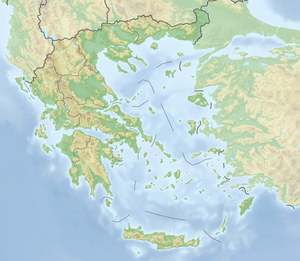Thermaic golf
| Thermaic golf | ||
|---|---|---|
| Waters | Aegean Sea | |
| Land mass | Balkan Peninsula | |
| Geographical location | 40 ° 7 ' N , 22 ° 54' E | |
|
|
||
| width | approx. 60 km | |
| depth | approx. 110 km | |
| Greatest water depth | 200 m | |
| Tributaries | Aliakmonas , Loudias , Axios , Gallikos | |
|
The Thermaic Gulf in Nea Moudania |
||
As Thermaic Gulf ( Greek Θερμαϊκός Κόλπος ) also Thermäischer Golf written, the marine area of the North West is Aegean referred. It lies between the Chalkidiki peninsula including its Kassandra peninsula in the east and the east coast of mainland Greece with the regional districts of Pieria , Imathia and Larisa with the Olympus massif in the west. The gulf was named after the ancient city of Therma (today's Thermi ), which used to be on the Gulf coast. Four rivers flow into the thermal gulf (clockwise): Aliakmonas , Loudias , Axios (Vardar) and Gallikos . The part located north and east of an imaginary line between Cape Megalo Emvolo (Karabonu) in the southeast and Cape Vardaris at the mouth of the Axios in the northwest is known as the Gulf of Thessaloniki . The central part of the thermal gulf (including the Gulf of Thessaloniki) is delimited by a line between Cape Epanomi in the east (west coast of Chalkidiki) and Cape Atheris in the west on the coast of mainland Greece and the border line to the Gulf of Thessaloniki.
The thermal gulf is a shallow sea area. Due to the sedimentation of the rivers, the water depth does not fall below 200 m even between Kassandra and Pieria. In the Gulf of Thessaloniki and in front of the mouths of the Aliakmonas and Loudias, the water depth is a maximum of 30 m.
Among the Romans, the gulf was known as Thermaeus or Thermaicus sinus ("Gulf of Therma") or Macedonicus sinus (" Macedonian Gulf").
The coastline has changed a lot since ancient times. The ancient city of Pella (capital of the Kingdom of Macedonia) was 500 BC. At a foothill of the thermal gulf. Sediment input from the Axios, Aliakmonas, Gallikos and Loudias rivers led to increasing siltation of the gulf and a decrease in water depth. Over the centuries, the northwestern foothills were initially separated from the thermal gulf as a lagoon and subsequently silted up. The shift of the coastline from 500 BC. Until 1960 it was up to 80 km in the direction of the open sea.
In recent times this process seems to be easily reversed. From 1960 to 1999 the coastline receded at a rate of up to 10 cm per year. The reversal of the silting process became evident through two flooding events, which were previously unknown in this form. In 1969 a storm surge occurred for the first time, during which the waters of the thermal gulf reached the houses in the village of Kalochori west of Thessaloniki. This led to the construction of a dike, which was completed in 1973. In addition, the foundations of the houses were raised by 1.5 to 2.0 m. In the winter of 1979/1980 Kalochori flooded again despite the existing dams.
swell
- ^ A b c S. Poulos, A. Papadopoulos, MB Collins: Deltaic progradation in Thermaikos Bay, Northern Greece and its Socio-economic implications. Ocean & Costal Management 22: 229-247 (1994).
- ↑ Herodotus , VII, 123-124.
- ↑ a b Stathis C. Stiros. Subsidence of the Thessaloniki (northern Greece) costal plain, 1960-1999. Engineering Geology 61: 243-256 (2001).
literature
- Leonidas Eumorphopulos: Changes in the Gulf of Thessaloniki , in: Geographica Helvetica, 18 (1963), p. 269 ff. ( Digitized version )

